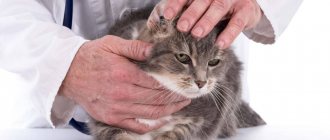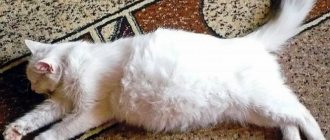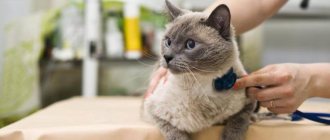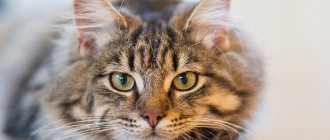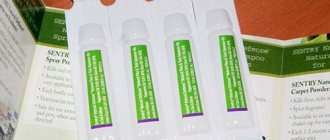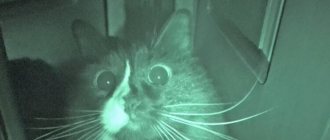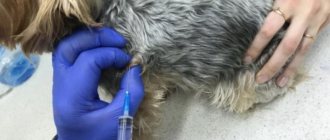At first glance, it may seem that this topic is of interest only to biologists and veterinarians: it is too complex and uninteresting. Have you heard from someone you know, or perhaps this has happened to you, that kittens that were born without problems and seem to be healthy suddenly die within the first three days of life? One of the most common reasons for this is the incompatibility of the blood groups of kittens and their mother.
Therefore, cat owners need to have an understanding of the basic principles of inheritance of blood groups, their incompatibility and actions in a critical situation. In 1953, English scientists determined and studied the blood groups of cats and the patterns of their inheritance.
Then, for thirty years, no one addressed this issue, since zoologists did not consider it important for the practice of cat breeding. It was not until 1981 that experiments by Auer and Bell proved the importance of this problem in transfusing blood from sick cats and in preventing the death of newborn kittens.
Cat blood types and their inheritance
At their core, blood groups are proteins located on the surface of erythrocytes (red blood cells) - antigens. Cat blood types are generally similar to human blood types. Cats have A, B and AB blood groups. Unlike most species of warm-blooded animals, antibodies that bind foreign red blood cells circulate in a cat’s blood already at the moment of its birth.
The existence of a zero blood group has not yet been discovered in cats. This is the difference between the blood groups of cats and humans. The patterns of inheritance of blood groups in cats have not yet been fully studied. It is known that the carriers of the hereditary code of blood groups - genes - are located next to each other on a certain chromosome. Allele “a” is dominant over allele “b”. Therefore, a cat with blood type B is homozygous for the “b” allele (that is, its genes contain only this allele), a cat with blood type A can be homo- and heterozygous for the “a” allele. The inheritance of the AB group has not been fully studied, but it is known that the parents of a cat with this group do not necessarily have to have groups A and B.
Blood antibodies react with antigens of foreign red blood cells, bind and destroy them. However, antibodies of different blood groups are not equally active towards their “enemies”. Thus, antibodies from cats with blood type B actively bind red blood cells contained in the blood of a cat with type A. Therefore, if blood of a cat with type B somehow gets into the blood of a cat with type A, the result may be the death of the animal. In cats with blood groups A and AB, antibodies are practically harmless to group B red blood cells.
Immune response to coronavirus SARS-CoV‑2 in patients with COVID‑19
Rumyantsev Alexander Grigorievich
Academician of the Russian Academy of Sciences, Doctor of Medicine Sc., President of the Federal State Budgetary Institution “NMITs DGOI named after. Dmitry Rogachev" of the Russian Ministry of Health
The article presents an analysis of the results of studies of the immune response and memory to SARS-CoV‑2, including all branches of adaptive immunity, immunoglobulins, memory B cells, CD8+ and CD4+ T cells in patients over time over 6–8 months after onset diseases.
Humoral link
Most people infected with SARS-CoV-2 seroconvert within a week of the onset of clinical signs of illness.
At week 2, antibodies are detected both to epitopes of the spike (RBD), or spike protein (S), and nucleocapsid (NCP) of the coronavirus (Fig. 1). The classic variant of the change IgM → IgG → IgA is broken. Secretory antibodies of class A are detected first in the 2nd week: on the 7th day - in 75%, on the 10-12th day - in 100% of patients. They are followed by an increase in macroglobulins (IgM) in the 2nd week and an increase in Ig G in the third week. The fact of the primary immune response of the mucous membranes to COVID-19 is unusual and requires explanation. Two hypotheses are discussed.
First: viruses contaminate the mucous membranes of the respiratory tract and gastrointestinal tract 7–14 days before the onset of a systemic response and clinical manifestations of infection, affecting microbiota cells - they are used for virus reproduction.
Second: cross-reactive antibody production, the premise of which is Spike-reactive CD4+ T cells, found in the majority of patients with COVID‑19 and in more than 34% of uninfected people. This confirms the existence of common epitopes of endemic coronaviruses that cause common ARVI and COVID‑19.
Importantly, immunoglobulin isotypes (either IgG or IgA) competed for neutralizing activity against SARS-CoV-2 depending on the location. Serum IgG antibodies were highly correlated with the magnitude of the IgG response and disease severity. In patients, for example, with an IgA nasal response, high virus neutralization activity was determined. The infection in such patients was asymptomatic.
This, on the one hand, suggests the possibility of neutralizing the virus with mucosal IgA without a systemic response, which is relevant to the outcome of the disease. On the other hand, due to the many correlations observed between the types of antibodies and their activity in different anatomical sites, the clinical interpretation of the humoral response is significantly difficult.
In addition, these data have important implications for our understanding of the protection of vaccination, which induces a systemic response to coronavirus vaccine genes or proteins through the classical pathway and provides a mucosal immune response 3–6 weeks after vaccination. Ideally, the vaccine should not only protect the recipient from an inevitable disease, but also prevent asymptomatic carriage, which would close the problem of asymptomatic carriers in the population.
Of interest is the dynamics of the levels of specific antibodies during the disease and after recovery (Fig. 2). Thus, SARS-CoV‑2 Spike IgG neutralizing antibody titers in the ELISA study were stable from 20 to 240 days (although heterogeneous among different patients) and ranged from 5 to 73,071 (median 575). The half-life (t1/2) was 140 days. The kinetics of SARS-CoV‑2 NCP IgG is similar to Spike IgG during 10 months of observation (t1/2—68 days, range—50 to 160 days) for recovered patients. Ultimately, 90% of patients had neutralizing antibody titers greater than 20 6 to 9 months after symptom onset.
Spike IgA and RBD IgA titers remained at a stable level throughout the entire observation period t1/2—210 days, but in some patients the level of specific IgA antibodies decreased significantly after 90 days.
There is no clear answer for seronegative COVID‑19 cases. Apparently, in addition to the protective effect of mucosal immunity, the response is directly related to the level of the SARS-CoV‑2 viral load. On the one hand, high viral loads are associated with an earlier antibody response, while patients with low viral loads may not seroconvert. On the other hand, the kinetics of the immune response may be an indicator of the rate of virus elimination in the patient.
Identification of specific memory B cells for Spike, RBD and NCP using fluorescently stained probes for IgD– and (or) CD27+ with subsequent differentiation according to isotypes of surface IgM, IgG or IgA showed the following. The number of specific B cells increased within 120 days after the onset of the disease and then reached a plateau, while Spike-specific memory B cells were practically absent in people who did not have COVID‑19. RBD-specific B cells appeared on day 16 and their numbers increased over the next 4–5 months. Interestingly, only 10–30% of Spike-specific memory B cells were specific for the RBD domain 6 months after the patients recovered.
NCP-specific memory B cells also steadily increased at the same time and were detected 5–6 months after the disease. The representation of immunoglobulin isotypes of Spike-specific B cells had the following dynamics. In the early phase (20–60 days) after the disease, IgM+ and IgG+ were equally represented on B cells. In the period from 60 days to 240 days, IgG+ Spike-specific B cells predominated. The frequency of IgA+ Spike-specific cells was approximately 5%, and they were evenly distributed throughout the entire observation period of 8 months. Correlation between serum IgA and mucosal IgA has not been performed.
A similar picture of dynamics was observed in the case of IgG+, IgM+ and IgA+ to the RBD and NCP epitopes of the coronavirus. At the same time, the long-term presence of circulating memory B cells directed against both the main SARS-CoV-2 neutralizing targets (Spike and RBD) and the non-neutralizing target (NCP) indicates cellular memory that persists after natural exposure to the virus . This can be used to plan revaccination. The fact that almost all RBD-specific IgG+ memory B cells expressed CD27 indicates long-term immune memory.
Analysis of the data obtained suggests that the decrease in neutralizing and other antibodies to SARS-CoV‑2 after clinical recovery is completely negligible. Simply, with the development and preservation of the memory of B cells that can be activated when encountering new strains of coronavirus, the level of antibodies in the serum decreases, while the IgA response of the mucous membranes remains at a constant level throughout the entire observation period.
Cellular response
The percentage of patients with detectable circulating memory CD8+ T cells one month after symptom onset was 70%. By 6–9 months, cells were found in 50% of recovered patients. Phenotypic markers showed that the majority of SARS-CoV‑2‑specific CD8+ T cells are terminally differentiated memory cells.
Circulating SARS-CoV‑2‑specific memory CD4+ T cells were detected in 93% of patients one month after the onset of the disease. After 6–9 months, the level of these cells was stable, and they themselves were detected in more than 90% of patients who had COVID-19. Moreover, this applied to both Spike-specific and membrane-specific memory CD4+ T cells.
Interestingly, when comparing parameters of the immune response in patients with severe and mild infection, humoral parameters were higher in severe cases, while CD8+ T cells were stable and CD4+ were lower in severe cases of the disease. There are no explanations for this phenomenon; it is important that a weak T-cell response is observed in the acute phase of the disease. In addition, the methodology for studying cellular immunity is also important.
Impaired cellular responses are illustrated by deficiencies of type I and II interferons in patients with severe and moderate forms of COVID‑19 compared with mild and asymptomatic cases of the disease. This may be due to the suppression of inflammation by interleukin-12 (IL-12) and the development of a secondary defect in cellular immunity.
Immune interaction
Of great interest is the study of the interaction of humoral and cellular responses to SARS-Cov‑2. In studies of RBD-IgG, Spike IgA, RBD-memory B cells, CD8+ and CD4+ T cells over time in the same patients, it was found that the majority of them (64%) had positive indicators after 1–2 month after the onset of the disease. After 5–8 months, the number of convalescents positive for five tests decreased to 43%. At the same time, at least three out of five tests were positive after 6–9 months. It is important to note that IgG to Spike gives an order of magnitude more positive responses than to RBD antigen. Attempts to link humoral-cellular interactions have not been successful due to the heterogeneity of study participants and methods for assessing the immune response.
Uncertain result
A meta-analysis of 22 studies (4969 patients) identified adverse features of severe disease and death, such as lymphopenia and neutrophilia. Because CD4+ T cells are essential for a balanced and effective immune response, it is not surprising that low lymphocyte counts may reflect hyperinflammatory processes and contribute to more severe disease and increased mortality.
Neutrophils, as an integral part of the innate defense, control the balance of the microbiota and the elimination of products of cellular destruction through the production of reactive oxygen species and the release of neutrophil extracellular traps in the venous bloodstream. Lymphopenia (less than 500 cells per 1 μl) indicates a 3-fold increase in the risk of severe disease and deaths with COVID‑19. Persistent neutrophilia with a shift to the left indicates depletion of the bone marrow reserve, and with a shift to the right it reflects impaired cell release into the tissue. This parameter, easily monitored by a blood test, indicates a more than sevenfold increase in a patient's risk of becoming seriously ill and dying from COVID‑19.
Attempts to identify patterns of immune response to SARS-CoV‑2 have so far been unsuccessful.
Firstly, we can conclude that those who have recovered from coronavirus infection retain immune memory for the next 6–9 months. Further dynamic studies will show at what time a decrease in the immune response occurs, requiring preventive vaccination and (or) revaccination.
Second, and very interestingly, each component of the immune response and immune memory studied exhibits different kinetics. This is due to the individual response to infection, the presence of premorbidity and the frequent transformation of monoinfection into mixed SARS-CoV‑2 infections with the activated microbiota of the patient.
Third, response heterogeneity may be a central feature characterizing immune memory to SARSCoV‑2. Biological specific IgG has a 21-day half-life, and antibody levels over time reflect the production of short-lived and then long-lived plasma cells. From the point of view of the disappearance of the pathogen within a few days after the appearance of the clinic, the process of antibody production should be reduced by 6 months, but if SARS-CoV‑2 Spike and RBD IgG persist longer than 8 months, this means that the virus persists in the host body or its microbiota. We cannot exclude a connection with a prolonged immune response of natural reimmunization by circulating epidemic alpha-coronaviruses that support the immune response.
Fourth, identification and analysis of SARSCoV‑2‑specific memory B cells can potentially be used as a marker of humoral response during vaccination. Currently, studies of the post-vaccination immune response are carried out using immunofluorescence analysis assessing IgM and IgG antibodies as markers of vaccine effectiveness (Fig. 3). ELISA diagnostic methods, unfortunately, are not standardized by single proteins S, RBD, NCP, the quality of which depends on antigen purification. Because the number of memory B cells is stable over time, they may represent a more reliable marker of the duration of humoral immune responses than serum immunoglobulins.
Thus, from the results of studies of the immune response in patients with COVID‑19, it is impossible to draw any conclusions about protective immunity during a new coronavirus infection. After all, the study of antibodies and memory cells in this disease has not yet been completed. This means that the discussed mechanisms of protective immunity against SARS-CoV‑2 in humans have not been fully determined.
Source: Newspaper “Pediatrics Today” No. 6, 2021
Link to original: https://www.medvedomosti.media/articles/immunnyy-otvet-na-koronavirus-sars-cov-2-u-bolnykh-covid-19/
Cat breeds and their characteristic blood groups
Research by American and English scientists has shown that certain blood groups are associated with the breed and habitat of cats. The vast majority of outbred domestic cats have blood type A. In the Siamese and related breeds (Burmese, Ocicat, Oriental), only group A has so far been identified. From 1 to 5% of Maine Coons and Norwegian forest cats
has blood group B. The presence of this group in Abyssinians, Somalis, Scottish Folds, Burmese, Kuril Bobtails and Persians is 5 - 25%, in Britons, shorthaired exotics and Rexes 30 - 50%. Blood type AB is very rare and only in those breeds that have both A and B groups.
Blood group incompatibility and its consequences
Blood type incompatibility can have tragic consequences in two cases. Firstly, the incompatibility of the blood of the mother cat and the kitten, leading to the destruction of the newborn’s red blood cells and his death. Secondly, blood incompatibility occurs during transfusion (blood transfusion). In this case, the animal is in serious condition, sometimes leading to death. Let's take a closer look at the first case, as it is more common and important for breeders of some cat breeds.
The difference in the blood type of a cat and her kitten is dangerous for the baby’s life when he has blood of type A or AB, the mother cat has type B, and the father cat has type A. In accordance with the laws of heredity, the kitten’s blood type is identical to the blood type father. For embryos in the cat's uterus, the mother's blood type, different from their own, does not pose a danger. After all, maternal blood antibodies, which destroy fetal red blood cells, practically do not penetrate the placenta. Kittens are born completely healthy, the birth proceeds without complications, but within a short period of time the following problems arise:
- kittens die suddenly on the first day without symptoms of any disease;
- kittens refuse mother’s milk during the first three days, become very weak, their urine turns red-brown (due to the entry of destroyed red blood cells), then soon die;
- kittens develop normally, feeding on mother's milk, do not have any ailments, but at the age of one to two weeks the tip of their tail dies off.
The cause of all these diseases is the entry of maternal antibodies, dangerous for kittens, into their blood. Antibodies are contained in the milk of a mother cat and, in the case where the blood types of the cat and kittens are compatible, are extremely important for the normal functioning of the baby’s immune system. Even though antibodies are large molecules, they are absorbed through the intestinal wall of newborn kittens and enter the bloodstream. In case of incompatibility, the mother's antibodies that bind red blood cells of blood type A (the one the kitten has) enter the baby's blood and cause agglutination (destruction) of the red blood cells. The number of red blood cells in the kitten decreases, and anemia occurs. Protein gets into the urine, resulting in kidney damage.
As a result, metabolism is completely disrupted. All this leads to the rapid death of the kitten. It happens less often that a kitten goes through a critical period. Then “the tip of his tail just dies off. This part of the body is located furthest from the heart, and blood passes there through the thinnest capillaries. Therefore, if there is incompatibility of blood groups, in the most favorable case, blood circulation is disrupted only there, and the tip of the tail, not receiving blood, dies.
Sometimes not all kittens from a litter get sick; some survive, although they also have a blood type incompatible with the mother’s. This is explained by the individual structural features of the intestinal wall, which does not allow dangerous maternal antibodies into the bloodstream. It is extremely rare that all kittens remain healthy, which happens when the content of antibodies in the milk of the mother cat is very low.
Leukocyte formula (leukogram) – percentage of different types of leukocytes
Neutrophils
– these are leukocytes that are responsible for the destruction of infectious (mainly bacterial) agents, for the formation of inflammatory reactions, nonspecific immunity, and the destruction of their own dead or damaged cells. Based on the shape of the nucleus, one can judge the age of the neutrophil and how long it has already been in the bloodstream. In young neutrophils (band) the nucleus has a bean-shaped shape, in mature (segmented) the nucleus is segmented. By increasing the proportion of young neutrophils, we can conclude about the degree and severity of the inflammatory reaction.
The norm of neutrophils from the total number of leukocytes is 60-75%, stab ones - up to 6%.
Eosinophils
– these are cells that participate in allergic reactions and provide antiparasitic immunity.
Normally there are 1-5%.
Basophils
– this type of leukocytes is quite rare in blood tests. They are involved in immediate hypersensitivity allergic reactions (anaphylactic shock).
Usually there are 0-1% basophils in the leukogram.
Lymphocytes
- the main cells of the immune system. They provide specific immunity, synthesize immunoglobulins (antibodies), and destroy their own mutated cells.
The norm for the total number of leukocytes is 18-25%.
Monocytes
– tissue macrophages are the largest leukocytes, which migrate from the blood quite quickly to the tissues, where they remain for most of life. They completely destroy foci of inflammation, foreign cells and proteins, and their own destroyed tissues. These are the most important cells of the immune system, which are the first to encounter the antigen and present it to lymphocytes to form a full immune response.
The norm of monocytes in the leukogram is 0-2%.
What to do in case of possible danger?
Of course, for breeds, it is advisable to know the blood types of your pets in advance and cross only animals with the same groups. American breeders advise that when breeding those breeds in which the occurrence of group B does not exceed 5% (Maine Coons, Norwegian Forest), to identify such animals and exclude them from the breeding process. If blood group B is more common in the breed being bred and this pair is crossed for the first time, in order to avoid troubles, it is worth determining the blood types of the kittens immediately after birth.
There is a special test for this, although it is quite expensive. For the test, one or two drops of a kitten's blood from its umbilical cord is enough. The blood typing test for adult cats is cheaper and more common. To do this, you need to take 1-2 milliliters of blood from the cat's paw. Kittens with identified blood type A should be immediately separated from their mother, who has type B, and find a temporary nurse for them - a cat with blood type A (a mongrel domestic cat is perfect) or feed the kitten with a cat's milk replacer. 2-3 days after birth, the kitten can feed on the milk of its mother. By this time, the permeability of the baby’s intestinal wall decreases so much that antibodies from mother’s milk cannot penetrate into the blood and the kitten’s life is not in danger.
If it is not possible to determine the blood type of newborns, the following options exist. Firstly, you can separate all kittens from their mother for 2-3 days after the first feeding and act in accordance with the above. Secondly, you can do a urine color test. To do this, after the first feeding (quite short), the kittens should massage their tummies, thereby stimulating the secretion of urine. The urine should be blotted with a cotton swab. Normally, urine should be almost colorless. If the urine is brownish, it means the kitten and its mother have incompatible blood types. The urine is colored due to the entry of destroyed red blood cells. Such kittens should be separated from their mother.
Preparing for the study
Blood (2 ml) in a test tube with an anticoagulant. (sodium citrate, K3EDTA, K2EDTA), buccal epithelium 2. A copy of the pedigree (optional) 3. The presence of a brand or chip (optional, at the responsibility of the donor) WITHOUT IDENTIFICATION, WE ARE NOT RESPONSIBLE THAT THE SENT MATERIAL BELONGES TO THE ANIMAL SPECIFIED IN THE DIRECTION. IMPORTANT for taking buccal epithelium: Two hours before the procedure for taking biomaterial, the animal should not be fed; isolation from other animals is desirable. For puppies and kittens, breastfeeding should be avoided at least two hours before taking biomaterial. It is recommended to rinse the mouth with water (for convenience, you can use a syringe). IF YOU ARE ONLY DELIVERYING MATERIAL, PLEASE READ THE INSTRUCTIONS
Is it possible to use cats with blood group B for breeding?
Blood type B is not a disadvantage of a purebred cat. This is the same feature as, for example, eye color or fur color. Such cats only require more attention from the breeder. After all, they need to choose partners especially carefully. If it is determined that a cat has blood type B, it is worth finding a cat with the same group for mating. If this is not possible, you need to prepare to separate newborn kittens from their mother for several days. A purebred cat with blood type B is an ideal partner for any cat, as is a cat with blood type A. Cats with blood type A can be safely mated with cats of the same type.
Sometimes, to achieve a certain goal, breeders have to cross a cat with type B with a cat with blood type A. In this case, fertilization often does not occur, although both animals are healthy and normally developed. Nature seems to resist such “marriages”. In Central European countries, blood type B is more common in the Persian breed. When breeding Persians, you should pay special attention to determining blood groups.
Lina Laslovskaya
5 / 5 ( 5 votes)
